
7 Essential Bedding Fabrics: A Guide to Choosing the Right Sheets (Pros & Cons)
A good night's sleep starts with the right bedding. The fabric you choose can affect comfort, temperature, and breathability.
By:
The Good Home Daily
Posted on February 18, 2025
We all know a good night’s sleep is like hitting the reset button. It sets the tone for everything. And guess what? Your bedding fabrics play a huge part. Choosing the right types of bedding materials can seriously improve your sleep quality
According to the National Sleep Foundation, mattresses and sheet sets are among the most important elements for getting a good night’s rest. The fabric of your bedsheets, pillowcases, and duvet covers directly affects crucial aspects like body temperature regulation, breathability, and overall comfort.
But first, what is included in bedding?
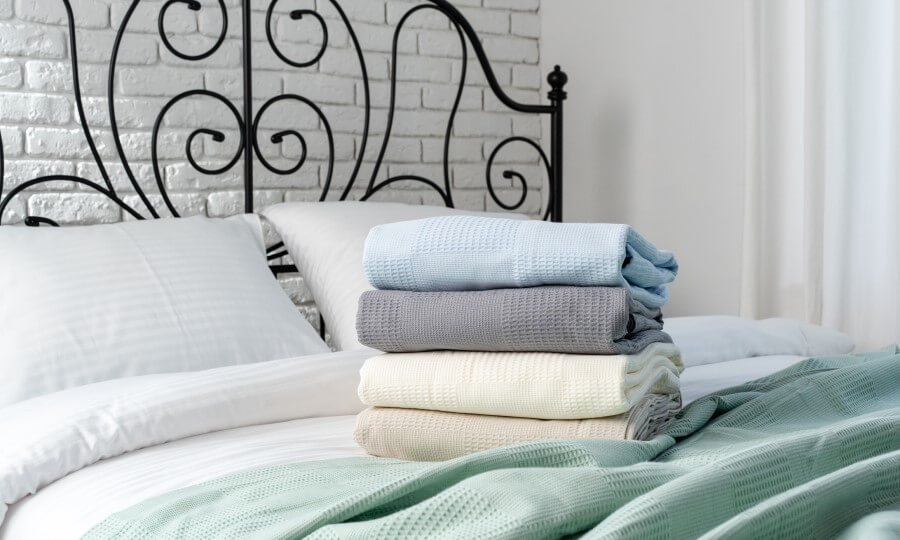
For starters, bedding includes much more than just a sheet. While it is often called bedclothes and bedlinen, bedding encompasses all the soft textiles that cover your mattress to create a comfortable and inviting sleep environment.
Here’s a breakdown of what makes up a complete bedding set:
- Sheets
As you may already know, a bed sheet is the foundation of bedding. This includes the sheet that wraps around the mattress and the flat sheet that covers you.It is important to choose a sheet fabric that is appropriate for the climate. For instance, during the summertime in the Philippines, breathable sheets are ideal. In colder months, cozy and warm fabrics are the better choice.
- Pillows (with pillowcases)
Pillows are also an important part of bedding. They not only play an important role in comfortable sleep, but pillows also add texture and style to your bed.When selecting pillowcases, look for options that are both durable and hypoallergenic, as they protect your pillow and come into direct contact with your skin and hair.
- Blankets
Blankets are a key component of bedding, even if some people choose not to use them. Their main role is to add warmth and an extra layer of comfort while we sleep. Like in bedsheets, you need to choose lightweight blankets for warmer months and find thicker options for colder weather. - Comforter
A comforter is a type of blanket filled with insulation material and encased in a fabric cover. They are used as a primary covering on a bed. That means you can use them on their own without a separate cover. The right fabric for your comforter will enhance your sleep experience and the overall look of your bedroom.
What are the best sheets for bedding?
Getting the best bedding, however, may not be that easy. Many factors come into play, including climate, maintenance requirements, and price. So we’ve compiled this guide to help you make an informed sheet-buying decision.
Here are the 8 best bedding fabrics to consider for the restful sleep you deserve.
1. Cotton Fabric

Cotton is the most popular and widely recognized bed sheet material. It’s likely what you picture when you think of bedding. This bedding material is loved for its versatility, affordability, durability, and comfort. But did you know there are different types of cotton, each with its own unique characteristics?
Here are some of the most common types of cotton used in bedding today:
- Egyptian Cotton: Extra-long fibers create exceptionally soft, strong, and luxurious sheets. Often considered the highest quality, but be wary of imitations.
- Pima Cotton: Similar to Egyptian, Pima cotton has extra-long fibers for soft, durable, and wrinkle-resistant sheets.
- Flannel Cotton: The cotton is brushed to create a soft, fuzzy texture that traps heat, making it ideal for colder climates and winter bedding.
- Percale Cotton: It’s known for its durability and smooth feel, and it is often described as having a “hotel-like” quality. Percale sheets are lightweight and get softer with each wash.
- Jersey Cotton: These sheets are known for their relaxed, casual feel and are often more affordable than other types of cotton. However, they may be less durable and prone to pilling.
- Upland Cotton: Upland cotton is the most common type of cotton. It has short fibers, making it less expensive. This is not as luxurious as the extra-long varieties but still offers decent softness and durability.
Pros of Cotton Bedding
Cotton bedding enjoys widespread popularity, and it’s easy to see why. The biggest advantage of cotton is its breathability. The natural structure of the fibers allows air to circulate freely, promoting airflow and preventing heat buildup. This makes cotton bedding a particularly good choice for those who tend to sleep hot
Beyond its comfort benefits, cotton is often recommended for people with sensitive skin or allergies. Its hypoallergenic nature means it’s less likely to trigger allergic reactions than synthetic materials, making it a gentle option for those prone to irritation or eczema.
Finally, cotton is known for its durability. It can withstand frequent washing and everyday wear and tear, making it a long-lasting investment. With proper care, cotton bedding can remain a staple in your home for years to come.
Cons of Cotton Bedding
While cotton fabrics offer a lot of advantages for bedding materials, they have also a few drawbacks. One common complaint is its tendency to wrinkle. Unlike some synthetic fabrics that remain smooth and crisp, cotton requires some attention if you desire a wrinkle-free appearance.g. That means it may require ironing for a crisp look.
While generally durable loosely woven cotton-like Jersey or other types of cotton that haven’t been pre-shrunk may also shrink slightly after washing.
2. Polyester Fabric
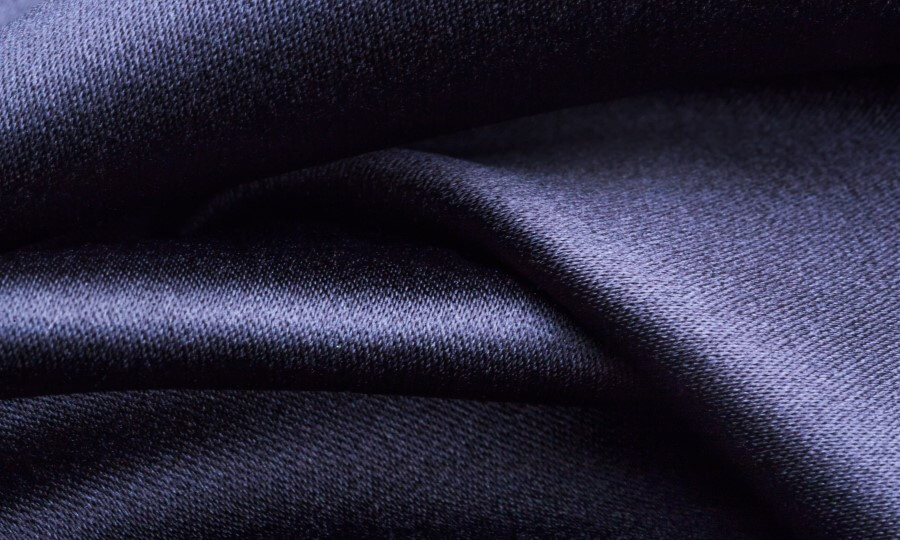
Polyester is a synthetic fiber, meaning it’s man-made from chemical compounds, primarily petroleum byproducts. It’s one of the most widely used synthetic fibers in the world. In fact, according to the Textile Exchange Preferred Fiber Materials Market Report 2021, polyester accounts for over half of the global fiber market and around 80% of all synthetic fiber use.
Interestingly, polyester is often blended with other fabrics to produce combined properties. For example, a cotton-polyester blend offers better breathability while retaining some of polyester’s durability and wrinkle resistance.
Pros of Polyester Bedding
Polyester is known for its durability. Its sheets can withstand frequent washing and drying without losing their shape or color, making them a long-lasting investment for your bedroom. In fact, this fabric is commonly used for area rugs and even outdoor rugs.
Polyester sheets are also easy to care for. They are wrinkle-resistant, so you can skip the ironing board.
Finally, Polyester sheets are generally more affordable than other natural fibers. This makes them a great option for budget-minded shoppers.
Cons of Polyester Bedding
Polyester is a synthetic fiber, so it doesn’t breathe as well as natural fibers like cotton. This can make it feel warm and less comfortable for some sleepers, especially in hot weather.
Polyester is also a good insulator of electricity. What does this mean for bedding? When you move around in polyester sheets, or when they rub against other fabrics, static electricity can build up. This can result in hair static, fabric clinging, or even a small shock when touching metal.
Beyond comfort and static, there’s a more serious concern about polyester: microplastic pollution. Multiple studies have found that polyester releases microplastics, and even more concerning is that everyday use releases even greater quantities of microfibers than washing.
A 2020 study from the University of Plymouth revealed that up to 4,000 fibers per gram of fabric could be released during a conventional wash, while up to 400 fibers per gram could be shed during just 20 minutes of normal activity.
3. Silk Fabric

Silk has a long history and can be traced back to the 4th millennium BCE in China. Back then, only the nobility had the privilege of using it. But thanks to the growing civilization, silk is now widely accessible for various household items, including bedding sheets.
Remarkably, silk is considered the strongest natural textile in the world. But, would you believe that it is made from the cocoons of silkworms? You read that right. Silk mainly consists of fibroin, which is a protein that certain types of insect larvae secrete to make cocoons.
While renowned for its durability, silk fabric is most coveted for its unparalleled softness—even softer than most kinds of cotton. It’s very soft, giving an almost slippery feel. Silk fabrics are also breathable and have a distinctive shimmering appearance.
Pros of Silk Bedding
Silk’s unparalleled softness, breathability, and comfort make it a coveted choice for bedding. These qualities benefit skin, hair, and sleep quality. Additionally, silk’s hypoallergenic nature makes it an excellent option for those with acne, sensitive skin, or allergies.
Cons of Silk Bedding
Silk is known and loved for its softness. However, not everyone is a fan of this level of softness. Some find silk sheets too slippery, which is one of the drawbacks of silk bedding.
Owning silk sheets may also require delicate care. Silk is a delicate fabric that can be easily snagged, torn, or damaged by rough surfaces or sharp objects. Careful hand-washing or machine-washing on a delicate cycle with a mild detergent is recommended. Silk should also be air-dried and kept out of direct sunlight to prevent fading and damage.
Finally, silk bedding is significantly more expensive than most other materials like cotton and polyester. This is due to the intricate production process and the relative scarcity of silk.
4. Bamboo Fabric

Bamboo fabric has gained significant popularity in recent years, particularly for bedding. This is thanks to its unique combination of softness and natural properties. While often advertised as a sustainable fabric, this will depend on the type of fabric.
The type of Bamboo fabric will depend on the process:
- Bamboo Rayon/Viscose: This is the most common type of bamboo fabric. This uses a chemically intensive viscose process, similar to making rayon. While the process involves chemicals, the resulting fabric is soft, smooth, and has excellent drape.
- Bamboo Lyocell: This is a more eco-friendly method of producing bamboo fabric. It uses a closed-loop system that recovers and reuses most of the solvents used in the process, minimizing environmental impact. Bamboo lyocell is also known for its softness, strength, and breathability.
- Bamboo Linen: This is the most sustainable type of bamboo fabric. However, it’s rare due to higher costs and labor. Bamboo linen fabric is coarser than bamboo viscose or lyocell, but is very strong and durable.
Pros of Bamboo Bedding
Bamboo fibers are naturally porous. This means the fabric is highly breathable, allowing for excellent airflow. This helps regulate body temperature, keeping you cool and comfortable in the summer.
Bamboo is also hypoallergenic and possesses natural antibacterial and antimicrobial properties. This helps inhibit the growth of bacteria and odors. So, if you have allergies or sensitive skin, bamboo fabric bedding is definitely a good choice.
Cons of Bamboo Bedding
Some types of bamboo fabrics, specifically bamboo viscose, are less durable than other bedding fabrics. This type of bamboo bedding is also prone to pilling or shrinking if not cared for properly. Among all types of bamboo fabric, bamboo linen is the most durable.
Bamboo sheets can be more expensive than cotton or polyester options, especially bamboo lyocell and bamboo linen.
5. Linen Fabric
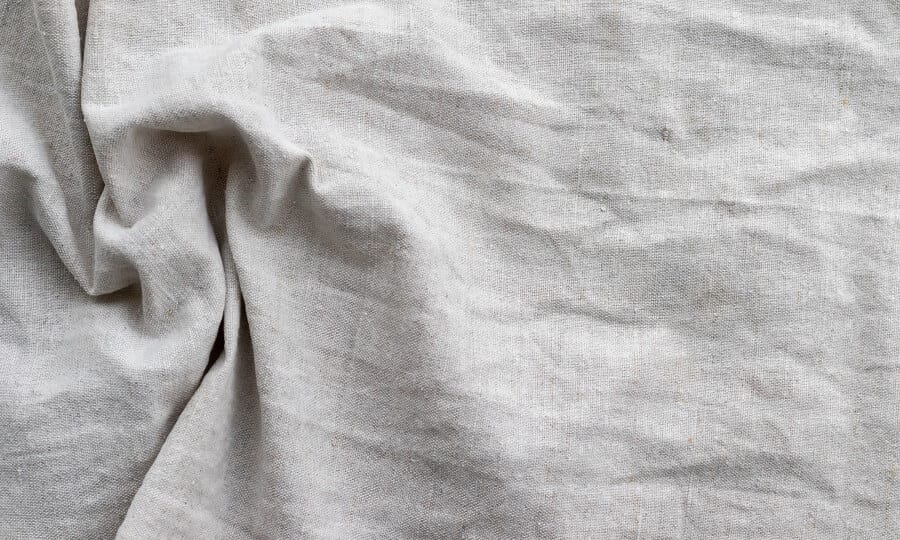
Linen, derived from the fibers of the flax plant, is one of the oldest textiles known to humankind. Its use can be traced back thousands of years. In fact, all the textiles discovered from Qumran are determined to be made solely of linen. What’s more, linen was used for mummification and burial shrouds in ancient Egypt and Rome.
Linen continues to be valued today, particularly for bedding. Thanks to its exceptional breathability, it’s also a favored material for lingerie, underwear, and flowing gowns.
Pros of Linen Bedding
As mentioned, linen fabric is known for its breathability. So, linen bed sheets are ideal for those who want to stay cool and comfortable in warm weather.
Linen is also an extremely durable fabric that can last you for many years. Amazingly, unlike some fabrics that wear down with washing, linen becomes softer and more inviting with each wash.
Cons of Linen Bedding
While linen bedding offers so many benefits, there are a few things to consider if you’re considering buying this fabric. First off, it’s not the cheapest option. It’s generally more expensive than cotton or polyester, so you need to be ready for that.
Linen wrinkles easily too. While this is part of its characteristic look, some people may find this undesirable. If you’re someone who prefers crisp, ironed sheets, linen might not be your best match.
6. Microfiber Fabric
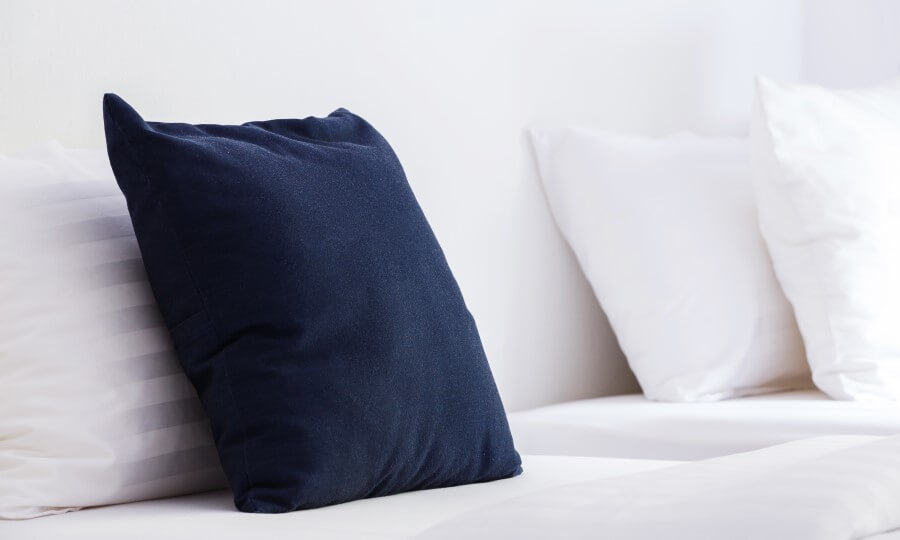
For starters, microfiber is a type of polyester. However, this material deserves its own category because of its unique properties and popularity in bedding. As the name suggests, microfiber is made of extremely fine synthetic fibers, much thinner than a strand of silk. This gives it a distinctive feel and performance characteristics.
Pros of Microfiber Bedding
Looking for soft, comfortable bedding that won’t cost a fortune? You will definitely love microfiber sheets. It’s softer and often better at wicking moisture compared to regular polyester fabrics. It’s also durable and resistant to shrinking and wrinkles, similar to other polyester fabrics.
Cons of Microfiber Bedding
Microfiber is considered an “upgrade” on regular polyester thanks to its luxurious smoothness and soft texture. However, many of the core drawbacks of polyester are still present in microfiber. These include lower breathability and the potential for microplastic shedding.
7. Satin
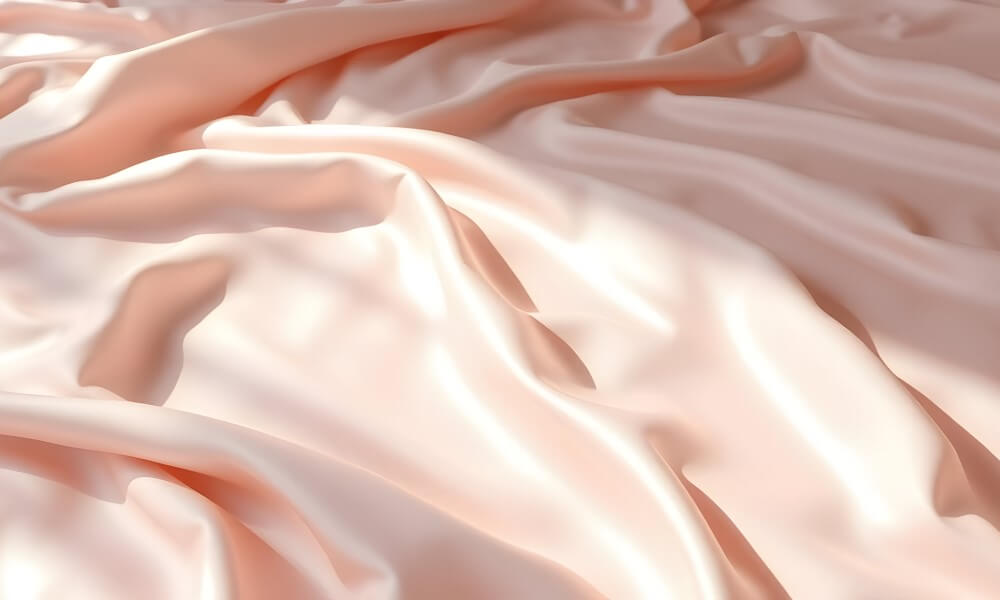
Satin isn’t a material like cotton or silk—it’s all about the weave. Think of it as a special way of looping threads together to create that signature glossy sheen and incredibly smooth, almost liquid feel. Because of this special weave, you can find satin sheets made from all sorts of materials. It can be made from various fibers, including silk, polyester, nylon, and even cotton. This means you can find satin sheets in a wide range of price points too and with varying properties.
Pros of Satin Bedding
One of the primary appeals of satin bedding is its luxurious feel. Its smooth, silky feel is incredibly comfortable. The surface of the satin can is also gentle on hair and skin reducing friction against hair and skin.
Cons of Satin Bedding
Before buying satin bedding, here are a few things to keep in mind. First, satin isn’t the most durable weave and can be prone to snags. Depending on the fiber (especially silk), it can be delicate and require special care when washing. So, you need to be very careful when washing it.
Finally, satin often comes with a higher price tag. This may not be the best fit for you if you have a limited budget.

